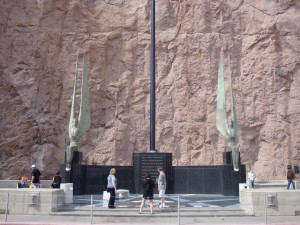 Monuments on the Nevada side of Hoover Dam honor the dam’s designers and builders, as well as the estimated 96 workers who died during its construction.
Monuments on the Nevada side of Hoover Dam honor the dam’s designers and builders, as well as the estimated 96 workers who died during its construction.
The largest sculpture at the dam site is the dedication monument, which stands near the visitors’ center on the dam’s Nevada (northwest) side. The monument, by Norwegian-American sculptor Oskar J.W. Hansen, depicts two winged allegorical figures sitting alongside a polished black diorite base.
The base of the monument, which also holds a large flagpole, bears a dedication reading, “It is fitting that the flag of our country should fly here in honor of those men who, inspired by a vision of lonely lands made fruitful, conceived this great work, and of those others whose genius and labor made that vision a reality.”
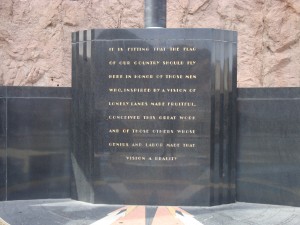 The 30-foot high bronze figures represent the combination of physical and intellectual strength used to create the dam, an engineering feat the sculptor compared with the construction of Egypt’s pyramids.
The 30-foot high bronze figures represent the combination of physical and intellectual strength used to create the dam, an engineering feat the sculptor compared with the construction of Egypt’s pyramids.
The plaza surrounding the monument bears the seals of the seven states that receive water or electricity from the Hoover Dam project, as well as an astronomical mosaic depicting the heavens on the dam’s dedication date of September 30, 1935.
Near the flagpole are two monuments honoring men who died during its construction. One, also by Hansen, features a muscular figure rising from a river. A dedication reads, “They died to make the desert bloom.”
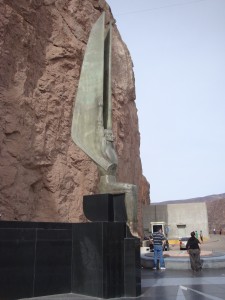 The monument has two dedication plaques. On the left (as you face the monument) a plaque reads, “The United States of America will continue to remember that many who toiled here found their final rest while engaged in the building of this dam.”
The monument has two dedication plaques. On the left (as you face the monument) a plaque reads, “The United States of America will continue to remember that many who toiled here found their final rest while engaged in the building of this dam.”
On the right, another plaque reads, “The United States of America will continue to remember the services of all who labored to clothe with substance the plans of those who first visioned the building of this dam.”
To the immediate right of this monument, the Boulder City Central Labor Council erected a plaque to honor laborers who died during the construction.
The number of workers killed during construction is officially recorded at 96, but the actual number may have been higher since contractors are believed to have reported carbon monoxide poisoning, a common hazard on the site, as pneumonia.
To the right of the Boulder City monument, two plaques honors Elwood Mead, who served as commissioner of the Bureau of Reclamation during the design and construction of 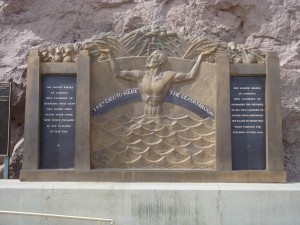 Hoover Dam. Lake Mead, which was formed by the dam, was named in his honor. An undated plaque appears to be from the mid-1930s, and a later plaque with additional information about Mead’s work was dedicated in 2007.
Hoover Dam. Lake Mead, which was formed by the dam, was named in his honor. An undated plaque appears to be from the mid-1930s, and a later plaque with additional information about Mead’s work was dedicated in 2007.
Hoover Dam
Hoover Dam was built between 1931 and 1935 to prevent flooding of farmlands near the Colorado River, to provide controlled irrigation to several states in the Southwest, and to power a hydroelectric plant that would serve Nevada, Arizona and California. Hoover Dam, the largest in the world at the time of its construction, is today regarded as an outstanding engineering feat and the dam remains a popular tourist location.
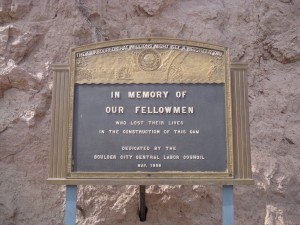 Hoover Dam, in the Colorado River’s Black Canyon, was originally planned to be constructed in the nearby Boulder Canyon before engineers decided Black Canyon offered a better choice. The dam was named after president Herbert Hoover, who lost the 1932 election to Franklin Delano Roosevelt. Roosevelt’s Secretary of the Interior, Harold Ickes, advocated removing Hoover’s name from the dam, and plaques on a building atop the dam refer to it as the “Boulder Canyon Project.” Hoover’s name was returned to the dam in 1947.
Hoover Dam, in the Colorado River’s Black Canyon, was originally planned to be constructed in the nearby Boulder Canyon before engineers decided Black Canyon offered a better choice. The dam was named after president Herbert Hoover, who lost the 1932 election to Franklin Delano Roosevelt. Roosevelt’s Secretary of the Interior, Harold Ickes, advocated removing Hoover’s name from the dam, and plaques on a building atop the dam refer to it as the “Boulder Canyon Project.” Hoover’s name was returned to the dam in 1947.
A large bridge is being built across the canyon to improve traffic flow along Highway 93. The two-lane roadway across the dam and security checkpoints as driver approach the dam have led to bottlenecks that the bridge is designed to help relieve.
 Sources: Bureau of Reclamation, Department of the Interior
Sources: Bureau of Reclamation, Department of the Interior
Wikipedia: Hoover Dam

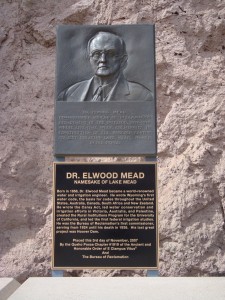
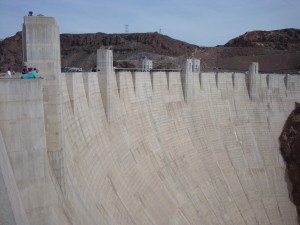



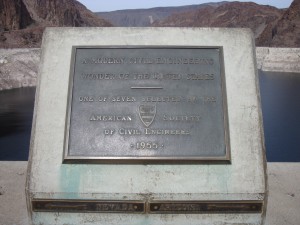
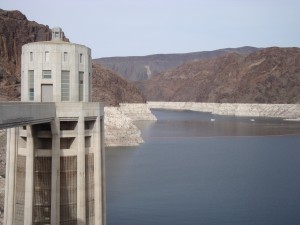
Dedicated on my birthday 09-30-1935. What an honor this was.
My Grandfather Richard Whelan was one of those who lost his life to construct this wonder.
This loss of life split a family. Richard was there with his wife and 2 sons, Richard 7, and Robert 5 (my Dad). After he died the family stayed on because his wife ( my grandmom ) had a job there. Within a year she died from flu and the 2 boys were sent home to Pittsburgh. I would love to do research about both my Grandparents because I know so little about them except the tradegy of loss.